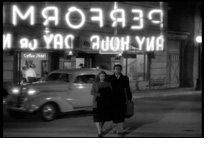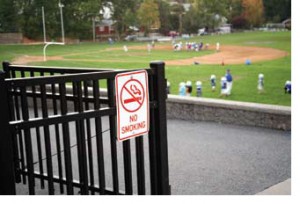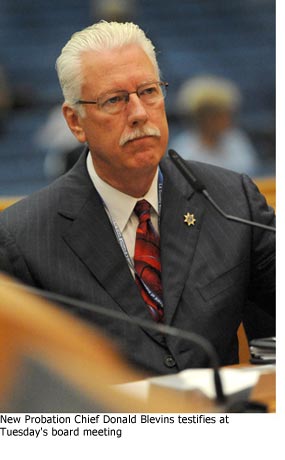A neon jungle cruise through downtown L.A.
June 23, 2010
 Starting Saturday, June 26, and continuing weekly thereafter through mid-November, the Museum of Neon Art’s award-winning summertime tradition returns with Neon Cruise 2010.
Starting Saturday, June 26, and continuing weekly thereafter through mid-November, the Museum of Neon Art’s award-winning summertime tradition returns with Neon Cruise 2010.
The revels begin at 7:30 p.m. with a wine-and-cheese reception at MONA, located downtown at 136 W. 4th St., between Main and Spring streets. Once urban explorers have sampled the drinks – and the displays – the adventure continues at 8:00 p.m. with a guided British double-decker bus tour by urban anthropologist Eric Lynxwiler, featuring the finest in neon displays from the Broadway Theatre District through Chinatown and Hollywood, concluding downtown where it all began by 11:00 p.m.
Neon signs have decorated the sets of thousands of films and TV programs over the decades, instantly establishing a moody atmosphere of seediness and despair for countless cop shows and murder mysteries. But neon is much than a backdrop, and for nearly 30 years, MONA has dedicated itself to showcasing the finest in neon sculpture and signage, preserving the old and curating showings of the new.
Tickets for the 2010 Neon Cruise are $45 for members and $55 for nonmembers; for further information, call (213) 489-9991. But whether you’re along for the ride or just dropping by for a visit, the experience will shed a little light on this overlooked and underappreciated 20th century art form. To get there, the Metro Trip Planner offers handy public transit options, or you can use these driving directions.
Posted 6/23/10
A new way to dam pollution
June 23, 2010
In a bid to improve water quality at a popular beach, Los Angeles County Public Works engineers will deploy an unusual weapon: a large, inflatable rubber dam.
The device, measuring 37 feet long and 4 feet high when inflated, will be used during the dry season in the Santa Monica Canyon storm drain to keep dirty water from flowing into the ocean at Will Rogers State Beach. The result, according to Bruce Hamamoto of the Department of Public Works: “There will be less bacteria at the beach.”
The rubber dam, scheduled to be installed in 2011, will replace an existing system that sends bacteria-laden water through sewers and into the City of Los Angeles’ Hyperion treatment plant near LAX, where harmful bacteria are removed. The new system will give water officials more flexibility to increase the amount of dirty water diverted to Hyperion.
Although rubber dams have been used by the county to help manage groundwater storage, this is the first use of a large dam along the coast to fight water pollution. (A small rubber dam was installed at the new Marie Canyon facility in Malibu last year.)
The rubber dam, essentially an inch-thick inner tube, allows officials to capture dirty water that would, on occasion, breach an existing 15-inch concrete dam, built in 2003. Now, when the water gets higher, the rubber dam can be inflated up to four feet high to divert more of the flow to Hyperion. Conversely, officials can deflate the rubber dam during storms to send water directly into the ocean and avoid flooding.
The $2 million dam, approved by the Board of Supervisors last month, represents the county’s portion of a joint project with the City of Los Angeles. The city will spend $6 million to double the size of the pipes that divert water through the sewers to Hyperion.
The dam project is part of a broader county effort to improve water quality at L.A.’s beaches by bringing pollution levels below those set by state environmental regulators.
More than 3 million gallons of water flow through the Santa Monica Canyon Channel on the average “dry season” day. Much of the water comes from the irrigation of lawns and gardens across a 10,000-acre swath of the Westside.
Post 6/23/10
L.A.’s great smoking divide
June 22, 2010
 Folks in San Marino, Malibu and Calabasas can breathe easy.
Folks in San Marino, Malibu and Calabasas can breathe easy.
But for those of you in Quartz Hill, Lancaster and West Hollywood—don’t throw away the nicotine patches just yet.
A new public health report on smoking in L.A. County is out, and it’s naming names. The report is the first of its kind to break out the county’s adult smoking rates by city and community. The disparities are striking.
San Marino boasts the county’s lowest rate of adult smoking, 5.3%, closely followed by Malibu at 5.8%. Next are La Canada-Flintridge (6.4%) and Calabasas (7.3%.)
“Our people in the community care about health. We care about and talk about healthy lifestyles,” says San Marino Mayor Dennis Kneier. His constituents, he says, “are very educated people who are aware of and conscious of the health risks of smoking.”
At the other end of the spectrum is Quartz Hill in northeast Los Angeles County, where 21.9% of the adult population smokes. Lancaster is next, at 21.7%.
“Coming from a long line of smokers, let me tell you: people up here smoke too much,” says Cindy Brody, a library assistant in Quartz Hill. “I was born here, and it hasn’t changed much in over 50 years. Face it, we’re not Hollywood.”
In West Hollywood, which has the fourth highest incidence of adult smoking in the county (19.6%), a task force of business and community leaders was convened in December to explore a new ordinance that would ban outdoor smoking on restaurant patios, open common areas and service areas such as ATM lines. The measure is expected to be brought before the city council in the next few months. The city already prohibits indoor smoking in public places and workplaces.
The county report draws on 2007 smoking data and population information from the 2000 U.S. Census. Some cities and communities, such as Avalon, Bradbury and Hidden Hills, were too small to be included. In all of Los Angeles County, there are an estimated 1.06 million smokers—14.3% of the adult population. (To see how your community ranks, scroll down to Table 1 of the report.)
Dr. Jonathan E. Fielding, the county’s director of public health, says in a foreword to the report that Los Angeles has one of the lowest smoking rates of any big metropolitan area in the U.S. He credits that to factors such as cigarette tax policy, “aggressive anti-smoking media campaigns” and smoke-free indoor ordinances.
He also reports that smoking among high school-age teens in Los Angeles County has declined dramatically, from 26% in 1997 to 12% in 2005. But smoking rates among adult smokers have remained steady since 2002. In addition to the heavy toll this takes on individuals and families, smoking also contributes to the $4.3 billion that tobacco-related diseases cost the county each year—$2.3 billion of it spent directly on health care.
Fielding said in a statement released with the report that the information is meant to help local leaders develop effective anti-smoking policies. “Understanding where smoking rates are highest in the county allows policy makers to develop support for and establish programs and policies in the fight against tobacco use,” Fielding said. However, the report does not attempt to correlate such policies with smoking rates in individual communities.
L.A. County‘s smoking disparities aren’t just geographic. The report says men smoke more than women, and African Americans light up more than other ethnic and racial groups. People with college degrees and higher incomes tend to smoke less than others.
In Quartz Hill, Brody, 55, thinks her community’s smoking habit can be partly attributed to economics.
“It’s a poor community, nobody has any money and they have nothing to do up here,” she says. She notes that long commuting distances also contribute to high stress levels for many.
Never a heavy smoker, Brody gave up cigarettes some 30 years ago.
“Now if I could get my husband to quit,” she says, “I’d be happy.”
This is the first L.A. County Public Health report to break out smoking rates by city and community. Previously, the department created such reports on childhood obesity and premature deaths from heart attacks and strokes.
Posted 6/22/10
Probation reforms temporarily tabled
June 22, 2010
 A series of measures aimed at swiftly improving the management and accountability of L.A. County’s scandal-plagued Probation Department was put on hold Tuesday when a short-handed Board of Supervisors could not muster the three votes needed for passage.
A series of measures aimed at swiftly improving the management and accountability of L.A. County’s scandal-plagued Probation Department was put on hold Tuesday when a short-handed Board of Supervisors could not muster the three votes needed for passage.
The matter was delayed a week after Supervisor Mark Ridley-Thomas—one of only three members present—left the board one vote shy by abstaining. Supervisors Zev Yaroslavsky and Gloria Molina, both of whom have been outspoken in their efforts to reform the department, had voted to move the measures forward.
Ridley-Thomas declined Molina’s offer to explain why he abstained at a time when the department is under increasing pressure to quickly restore public confidence. “I don’t know why anybody would object to these…motions,” said Molina, the board chairman. In fact, Supervisor Michael D. Antonovich, who is out of town, had encouraged his board colleagues in an e-mail to press ahead, despite his absence. He called the motions “vital.”
In recent weeks, the 6,000-person department has been rocked by disclosures, including reports that employees used county credit cards to buy electronics goods, that dozens of employees accused of misconduct may escape discipline because the investigations ran too long and that the department cannot fully track $79 million allocated by the Board of Supervisors to hire personnel.
The three motions at issue on Tuesday were intended to provide the department’s newly named chief, Donald Blevins, with ways to increase the effectiveness of his management team and provide tougher oversight of the department’s internal investigations and discipline.
Two of the motions were co-authored by Yaroslavsky. One, written with Antonovich, would expand the responsibilities of the Office of Independent Review to include oversight of the Probation Department. For nearly a decade, the OIR’s work has been largely confined to monitoring the operations of the Sheriff’s Department.
The second motion—this one co-authored with Molina—asks the CEO, County Counsel, personnel officials and others to explore within 30 days how Blevins could, under Civil Service rules, begin hiring managers from outside the Probation Department—a break with current practices.
The third motion, authored by Supervisors Antonovich and Don Knabe, attempts, among other things, to insure that that no employees in the future escape discipline because of unnecessarily long internal investigations and that probation officials responsible for such lapses in the past be held accountable.
At Tuesday’s meeting, Yaroslavsky emphasized that “time is of the essence”—a sentiment that brought agreement from Blevins, the former probation chief of Alameda County. He said he understands the board’s “clear message” that it’s his job “to clean up the department.”
Posted 6/22/10
Before pot vote, consider health impact
June 22, 2010
 With California voters set to decide in November whether to legalize marijuana, Los Angeles County’s top health officer has come up with an analysis of the drug’s effects.
With California voters set to decide in November whether to legalize marijuana, Los Angeles County’s top health officer has come up with an analysis of the drug’s effects.
Dr. Jonathan E. Fielding’s June 8 report to the Los Angeles County Board of Supervisors draws on an array of studies from authorities, including the American Medical Assn. to examine what marijuana does to the health of those who use it medically or recreationally.
“We really tried to be very objective,” said Fielding, the county’s director of public health. He said he was moved to create the report because of a shortage of comprehensive data on the subject.
“There’s a lot of mythology on all sides here,” he said in an interview. “Trying to understand what the science says is often a good first step.”
Fielding’s analysis does not come down on either side of the initiative, but includes statistics about how often marijuana use is a factor in some treatment and hospital settings.
One-third of those admitted to Los Angeles County substance abuse treatment facilities say that marijuana is their primary or secondary drug of choice, the report said. Nationwide, it contributed to 375,000 emergency room visits in 2008.
“Marijuana is a significant public health problem,” Fielding said.
Used medically, though, it may be effective in treating a few conditions, the report found. In addition to treating nerve pain, it also can help combat severe weight loss, alleviate some multiple sclerosis symptoms, fight chemotherapy-related nausea and vomiting and relieve eye pressure from glaucoma.
As for recreational use, Fielding’s report states that marijuana is consistently associated with difficulties in learning and remembering new information, along with lower test scores and decreased levels of academic achievement. Studies also have found that marijuana use correlates to increased consumption of other drugs. But it has not been “consistently associated with other measures of mental and psychological harm,” the report said.
The report, citing national surveys, says that more than 30% of people 18 and older who’ve used marijuana in the past year are classified as dependent on the drug. But that number is greatly reduced when actual “diagnostic criteria” for substance dependence are considered. Under that measure, between 4% and 9% of marijuana users are addicted. Overall, Fielding reported, marijuana users are “considerably less likely to [become dependent] than users of alcohol and nicotine, and withdrawal symptoms are less severe.” Still, younger users face higher risks, with 17% of those who’ve used the drug at age 13 becoming addicted.
Other findings:
- One recent clinical trial involving marijuana smokers had to be halted early when some participants started having suicidal thoughts.
- Marijuana’s association with psychosis is “somewhat controversial.” Although some recent studies suggest an increased psychosis risk associated with marijuana use, “marijuana accounts for only a small proportion of psychoses.”
- Smoking marijuana, like smoking tobacco, has been linked to lung damage and chronic bronchitis. Additional long-term studies are needed to determine whether marijuana smoking leads to an increased risk of lung cancer or other cancers of the oral cavity and airway.
The initiative to legalize, regulate and tax marijuana will appear on California’s November 2 ballot. It would allow people over 21 to grow and possess the drug and would permit local government to regulate and tax its sale. It would prohibit using marijuana in public or when minors are present, and would not allow its possession on school grounds,
Posted 6/22/10
Pushing for change in Probation Dept.
June 17, 2010
Outraged by a continuing stream of revelations, the Board of Supervisors is set to consider two measures aimed at intensifying oversight and accountability in the county’s Probation Department, which has been rocked by financial lapses and management failures.
In recent months, the 6,000-person department has been embarrassed by disclosures that it was unable to account for the expenditure of $79 million dollars allocated by the board, that probation youth had been allowed to conduct videotaped boxing matches in Juvenile camp classrooms and that more than two dozen officers accused of serious misconduct could escape discipline because the investigations exceeded a one-year statute of limitations.
Moreover, it was disclosed this week that the county’s Auditor-Controller has uncovered numerous instances in which Probation employees may have used department credit cards to illegally purchase electronics and other items for personal use. A criminal investigation has been initiated.
“The Probation Department has lost its sense of mission,” concluded Supervisor Zev Yaroslavsky. “The mission became more about them than about the clients they serve.” In an effort to get the department back on track, Yaroslavsky has co-authored two motions scheduled to come before the board on Tuesday.
One, with Supervisor Michael D. Antonovich, would expand the responsibilities of the Office of Independent Review to include oversight of the Probation Department. For nearly a decade, the OIR’s work has been largely confined to monitoring the operations of the Sheriff’s Department. In March, however, the board asked the OIR to examine the Probation Department’s internal investigations. OIR concluded that sweeping reforms were needed. Yaroslavsky and Antonovich are pressing for the OIR to assume those duties.
The second motion—this one authored with Supervisor Gloria Molina—is aimed at giving newly-appointed Probation Chief Donald Blevins greater latitude in assembling a “competent and effective” team of leaders. To that end, the motion asks the CEO, County Counsel, personnel officials and others to explore within 30 days how Blevins could, under Civil Service rules, begin hiring managers from outside the Probation Department—a break with current practices.
This hiring shift is considered crucial for Blevins, who says he is determined to weed out bad managers and reform the agency from top to bottom. In a statement to the media on Wednesday, Blevins warned:
“It is my responsibility to investigate the allegations of fraudulent activities that are said to be taking place and I assure you, those who have violated my trust, will be punished and/or removed from this Department. I have a zero-tolerance for misbehavior within my organization. The standard level that I hold every single employee within this Department is that of professionalism and high personal integrity. If this is too much for any employee to handle, then perhaps they made a poor career choice. These are sworn officers and they must act accordingly.”
For an interview with Blevins shortly after he was hired in April, click here
Posted 6/17/10
“A Midsummer Night’s Dream” in Topanga
June 17, 2010
 One of Shakespeare’s most delightful and romantic comedies could have been written especially for the Will Geer Theatricum Botanicum, an intimate and unique outdoor amphitheater nestled in the heart of Topanga Canyon.
One of Shakespeare’s most delightful and romantic comedies could have been written especially for the Will Geer Theatricum Botanicum, an intimate and unique outdoor amphitheater nestled in the heart of Topanga Canyon.
Fittingly for the onset of summer this week, on Sunday, June 20 at a 3:30 p.m. matinee, the Will Geer Theatricum Botanicum once again presents a season’s premiere of its signature production, “A Midsummer Night’s Dream.” Audiences delight in the authentic forest setting for Shakespeare’s enchanting tale of fairies, mortals, romance, magic and mystery. Celebrate Father’s Day with a timeless classic presented on nature’s very own stage. The Theatricum Botanicum is located at 1419 Topanga Canyon Blvd. in Topanga. Here is the ticket information, and here’s how to get there.
Actor Will Geer’s cherished family project has a rich and storied history reaching back to the darkest days of the 1950s Hollywood blacklist, when Geer, like many actors barred by their personal politics from working under the old studio system, embarked on his own independent acting and performing endeavors. The result was his Theatricum Botanicum, originally a haven on his Topanga estate for other actors, singers and writers similarly disenfranchised from mainstream artistic employment. After Geer’s death in 1978, his family expanded the Theatricum’s artistic offerings and educational opportunities into a thriving performing troupe and an integral part of both the Topanga and the larger Southern California cultural community.
Opening night gala at the Hollywood Bowl
June 17, 2010
 The Hollywood Bowl’s 2010 Summer Season kicks off in style with an opening night gala on Friday, June 18. Three new artists will be inducted into the Bowl’s Hall of Fame: the legendary Carpenters pop duo, with Richard Carpenter accepting on behalf of his late sister, Karen; disco diva Donna Summer, veteran of several sold out concerts since her Bowl debut in 1979; and renowned pianist Jean-Yves Thibaudet, a frequent Bowl favorite. The inductees will be introduced by celebrity presenters, and concertgoers can look forward to additional surprises and fresh performances of both classic pop hits and classical music. Principal Guest Conductor Thomas Wilkins again commands the baton for the Hollywood Bowl Orchestra. And, of course, the evening will be capped by the Bowl’s crowd-pleasing fireworks spectacular.
The Hollywood Bowl’s 2010 Summer Season kicks off in style with an opening night gala on Friday, June 18. Three new artists will be inducted into the Bowl’s Hall of Fame: the legendary Carpenters pop duo, with Richard Carpenter accepting on behalf of his late sister, Karen; disco diva Donna Summer, veteran of several sold out concerts since her Bowl debut in 1979; and renowned pianist Jean-Yves Thibaudet, a frequent Bowl favorite. The inductees will be introduced by celebrity presenters, and concertgoers can look forward to additional surprises and fresh performances of both classic pop hits and classical music. Principal Guest Conductor Thomas Wilkins again commands the baton for the Hollywood Bowl Orchestra. And, of course, the evening will be capped by the Bowl’s crowd-pleasing fireworks spectacular.
Following Los Angeles Philharmonic tradition, all proceeds will support Music Matters, the Phil’s music education programs.
Tickets may be ordered on-line through Ticketmaster. This Hollywood Bowl seating chart will help you select a good spot.
The Hollywood Bowl is located at 2301 North Highland Avenue in Hollywood; see the Map and Directions page for full details on how to get there, or call (323) 850-2000 for additional information.
Posted 6/17/10
Summer Solstice, Southern California Style
June 17, 2010
The ancient Druids of Stonehenge had their own distinctive way of celebrating the Summer Solstice, the first day of summer and longest day of the year. In the Southern Hemisphere, that occurs in December, but in the Northern Hemisphere, that occurs—next week, on June 21!
Southern Californians have their own unique summer rituals, too. And one of these is the Franklin Canyon Solstice Hike, taking place on Saturday night, June 19 at 7:30 p.m. at Franklin Canyon Park in Beverly Hills. Here you can celebrate summer’s arrival with a moderately strenuous two-hour hike guided by a volunteer naturalist. He’ll unveil the mysteries surrounding the changing seasons, planetary alignments, changing constellations and all manner of natural and cosmic wonders.
Franklin Canyon Park is located at 2600 Franklin Canyon Drive in Beverly Hills. Call (310) 858-7272 ext. 131 for more information. Leave your dog at home, but don’t forget to bring a jacket and flashlight. Check for ticks when you’re finished, and watch out for the poison oak, always remembering “Leaves of three, let it be.”
Visit http://www.lamountains.com/ for more terrific daytime and evening programs exploring our wilderness and open spaces. And by the way, learn how you can support your mountain parks and become involved as a naturalist or other volunteer right here.
Posted 6/17/10












 Check for the latest closure information
Check for the latest closure information








